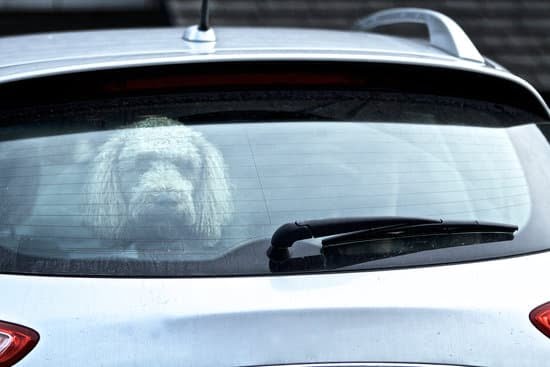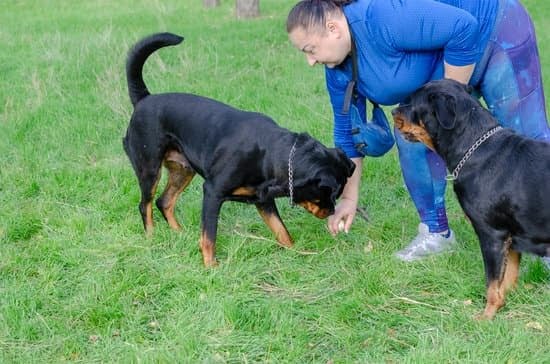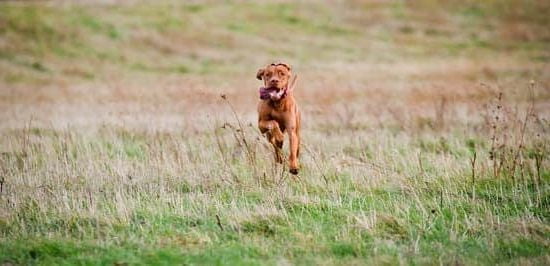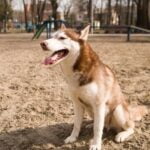Introduction
Jumping up and nipping are two common behaviors in dogs that owners may want to train out of their pets. Generally speaking, jumping up and nipping are expressions of excitement or dominance. Jumping up can often be seen as a way for a dog to try and reach a person’s face as a means of displaying affection or begging for attention, while nipping usually results from over-exuberant playtime with an owner or another animal. When uncontrolled, these two behaviors can quickly become nuisances that can lead to more serious issues affecting the bond between a pet and its owner.
The dangers associated with jumping up and nipping go beyond simple nuisance value; if left unchecked, these behaviors can quickly become dangerous; jumping up on people could cause them to trip and fall, while nipping might subliminally signal aggression towards other animals or people. As such, it is important for any dog guardian to implement training techniques as soon as possible when any of these issues arise. This guide will help explain the various techniques used in remedying this behavior in dogs and some potential steps one can take at home when attempting to address these issues correctly.
When attempting to train out jumping up and/or nipping issues within a dog’s behavior, there must be an implementation of consistent boundary setting along with positive reinforcement. In terms of boundary setting, owners should attempt to only reinforce actions that demonstrate obedience rather than those which encourage the unwanted behavior This may require some initial planning with regard to how such boundaries are created; allowing walking off leash in certain areas but not others or within certain parameters (staying close is suggested) is one approach among many that could assist in this process. Additionally, owners should demonstrate firmness when commands are given – making sure the pup comes running back immediately after being called – exhibiting clear ownership of their space even if outside traditional settings. It’s also effective for owners to aim for consistency over duration – meaning individual training sessions don’t have to take very long comparatively (15 minutes tops). It instead relies upon the repetition of commands so that they become second nature eventually – just like muscle memory does!
To support this structure further is the use of positive reinforcement such as treats or petting whenever an action is done well by the pup so that gradually his responses become more focused on pleasing humans than simply displaying whatever whimsical notion is present in his head at any particular moment! Allowing rewards after correct responses helps both enforce good habits while providing motivation for continued obedience – ensuring stronger protective responses each time too because there’s clearly something beneficial awaiting after doing things right each time!
Explanation of the Reasons why Dogs Jump Up and Nip
Jumping up and nipping are two common behaviors seen in many dog breeds. Both of these behaviors can be problematic, so it’s important to understand why they occur in order to learn how to correct them.
For many dogs, jumping up is a natural way of greeting someone. Dogs may jump up on people they meet, to get attention, or just because they are excited. Similarly, some dogs may also nip at an owner’s hands or feet when they become overwhelmed by excitement or get too close for comfort. In some cases this behavior is even seen when puppies play with owners or other animals; it is their way of playfully engaging with others.
In addition to exhibiting these behaviors from a natural inclination, both jumping up and nipping may be caused by improper training or lack of socialization in a pup’s environment. Poorly managed training can cause a pup to become confused as to what is and isn’t acceptable behavior while around humans and other animals and result in inappropriate behaviors such as jumping up and nipping. Similarly, failing to socialize a young pup can lead them to become scared of new people, environments, and activities which can manifest in aggression such as nipping and jumping up on strangers.
It’s important for pet owners to understand the potential reasons trigger their pup’s unwanted behaviors so that proper training methods can be implemented accordingly . With patience and consistent reinforcement any dog can overcome these tendencies through positive reinforcement techniques!
Benefits of Positive Reinforcement Strategies
Positive reinforcement strategies are the cornerstone of successful dog training. Positive reinforcement can help teach acceptable behaviors, reduce and modify undesirable behaviors, and build strong relationships between pet parents and their furry friends.
A few benefits of positive reinforcement strategies when it comes to reducing jumping up and nipping behavior include: providing a reward for a desired behavior; strengthening the bond between dog and owner; increasing compliance to commands; teaching alternative behaviors that replace nipping or jumping up; improving understanding of cues and communication; creating an environment where obedience is rewarded; satisfying the dog’s natural instinctive desires through rewards instead of punishment; preventing future behavioral problems from occurring; diminishing frustration in both dog and owner; teaching delayed consequences which increases the chances that undesirable behaviors won’t reoccur; and helping dogs understand how to appropriately interact with humans.
Overall, positive reinforcement strategies offer pet owners effective ways to encourage desirable behaviors in their furry friends while reducing or eliminating unwanted (and potentially dangerous) behaviors such as jumping up or nipping. Through consistent use of positive reinforcement techniques, pet owners can ensure their canine companions become obedient companions with whom they can enjoy happy and safe walks together. Thorough training is also essential for promoting good emotional wellbeing in pets as well.
Alternatives to Establishing Boundaries
One alternative to establishing boundaries for a dog jumping up and nipping is positive reinforcement. This involves praising the dog for good behavior and giving it treats when it reaches the desired outcome. Positive reinforcement helps dogs learn what is expected of them, as well as increase their motivation to perform behaviors that are nurtured rather than scolded.
Another option would be teaching a “leave it” or “off” command in order to encourage alternatives to these behaviors. This can be done by offering treats when the dog stops jumping up or nipping, teaching them that this behavior does not gain rewards and reinforcing that sitting calmly instead earns them rewards.
Lastly, interactive toys can help divert attention away from undesirable behaviors as they require dogs to think and use their mental energy. Interactive toys also help develop a greater bond between pet and owner while keeping dogs intellectually stimulated and mentally exhausted so they are less likely to resort to dangerous behaviors like jumping up or nipping out of boredom or frustration.
Opportunities to Teach Commands
Dog training is an important process for owners and their pets. One of the common behaviors that owners can work on with their pets is jumping up and nipping. This occurs when a dog feels excited and tries to greet the owner or other people by jumping up and nipping them. It’s important to start training as soon as possible to show the dog that this behavior is not acceptable.
There are several ways pet owners can begin teaching commands related to jumping up and nipping. One option is to train the “sit” command, so that instead of jumping, the dog will simply sit down in order to greet people properly. Another option is to teach a “leave it” command, which can be used if someone notices their pet trying to jump up or nip at another person or animal. Teaching these commands requires patience and consistency; pet owners may need to offer lots of positive reinforcement in order for their pet to learn them quickly and effectively. Additionally, it helps for pet owners to pay close attention when their pet interacts with others in order for them quickly redirect unsocialized behavior before it escalates out of control. With patience and repetition, owners can use these opportunities as a chance for their dog to learn the proper way of greeting people without jumping or nipping
Positive Outcomes for You and Your Dog
Dog training can be a difficult and time-consuming process, but the results are worth it both for you and your dog. Training your pup to stop jumping up on people and nipping inappropriately will help build an even stronger relationship between the two of you. Positive reinforcement is key in helping your dog understand what behaviors are acceptable and which are not. Start by rewarding them for behaving properly when approached, then moving on to correcting their bad behavior until they make the connection that their desired outcome is achieved through proper action. Over time, this will become second nature for your pup and both of you will be able to enjoy the occasional cuddle without feeling uncomfortable. Also, regularpet playtime with appropriate sizing toys like chewies or balls helps keep their teeth healthy while also providing quality entertainment they can actively participate in. Knowing that they get positive rewards when acting appropriately around people will help themnaturally grow confident both around friends, family, or strangers as well as feel secure in their own home environment – all through routine training that reinforces correct behaviors every single day.
Suggestions for Troubleshooting Difficult Situations
One suggestion for troubleshooting difficult situations with dog training is to consider the environment in which the unwanted jumping up and nipping is taking place. Is there a lot of commotion and excitement? Are there any other pets or children around? If so, these could be distractions that are making it difficult for your pet to stay focused on the intended behavior. Additionally, you should evaluate whether there is an underlying behavioral issue at play, such as anxiety or fear, that may need to be addressed through additional training methods such as desensitization and counterconditioning. Lastly, make sure that the reinforcement you’re using is effective enough that they can understand your expectations.
Closing Remarks and Tips
When it comes to training your dog to not jump up on people or nip, patience and consistency are key. The most effective way to discourage these behaviors is through reward-based positive reinforcement training. This involves rewarding your pup for desired behaviors and ignoring undesirable behaviors. Remember that dogs live in the moment, so they may take multiple repetitions over a period of time before they understand what behavior is appropriate.
Additionally, when you are actively training your pup, ensure that you are focusing on their demeanor – do not engage them when they are excessively excited or overly vocal as this will only reinforce their bad habits. Instead, have your pup remain in a sit position until calm for some time before proceeding with your activity together. Next, set up situations where you can reward them for positive behavior such as an extended sit or looking away from a person or other animal instead of jumping up or nipping; also use verbal cues like “sit”. Finally, be sure to reward your pup liberally and frequently when they display the correct behavior by providing treats and words of affirmation. By sticking with this plan consistently, eventually the puppy’s behavior will start to change over time into the desired result.

Welcome to the blog! I am a professional dog trainer and have been working with dogs for many years. In this blog, I will be discussing various topics related to dog training, including tips, tricks, and advice. I hope you find this information helpful and informative. Thanks for reading!





